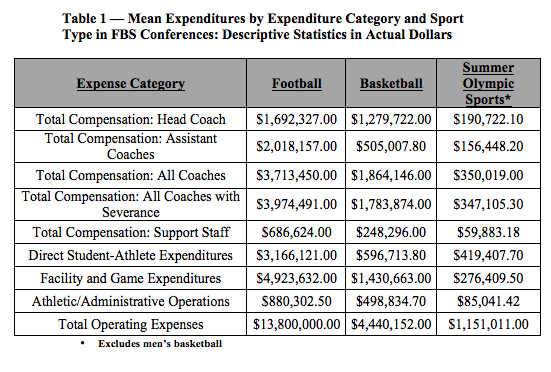
While revenue-generating collegiate sports such as men’s football and men’s basketball traditionally garner much of the debate on athletic finances, Olympic sports play a key role not only in annual athletic budgeting practices but also the overall athletic culture. While a number of researchers have examined the financial vitality of revenue-generating sports, this study hopes to begin the conversation about how financial decisions—both quantity of resources and resource allocation—are connected to both academic and athletic outcomes within Olympic sports. In particular, this review aims to:
1. Conduct a review of the financial efficiencies of collegiate sports traditionally competing within the summer Olympic games while estimating the potential returns on (a) academic and (b) athletic outcomes
2. Utilize a multiyear and multisport fixed-effects regression model to estimate the sport-level effect of expenditures on Olympic sports
3. Discuss the existence of possible trade-off in terms of resource allocation strategies to inform athletic administrators as they make decisions within the current economic climate
This study builds on the previously released studies on the Football Bowl Subdivision (FBS) football and men’s basketball expenditures in December 2011 and March 2012. In particular, overarching results indicate the following:
1. Financial priority of the summer Olympic sports (measured by the percentage of total athletic budgets going towards an individual sport) matters in terms of winning percentage—on average a 5-to-1 relationship.
2. Academic progress rate (APR) scores of summer Olympic sports do not appear to be positively or negatively connected to either amount or distribution of the sport-level expenditures.
3. Unlike in men’s football and men’s basketball, there does not appear to be a direct trade-off between athletic and academic success.
Table 1 provides a foundational understanding of the expenses related to the macro-financial categories in Olympic sports as they related to men’s football and men’s basketball. As evident, Olympic sports have substantially lower expenditure categories and total budgets. Coaches’ compensation and support staff represent the biggest divide between revenue-generating and summer Olympic sports.
Definitions:
1. Total Compensation: All Coaches – includes all expenditures (direct or third party) paid to both head and assistant coaches along with severance packages
2. Direct Student-Athlete Expenditures – includes athletic student aid; equipment, uniforms, and supplies; medical expenses and medical insurance; and recruiting expenses
3. Facility and Game Expenditures – includes direct facilities, maintenance, and rental; game expenses; guarantees; indirect facility and administrative support; and team travel
4. Athletic/Administrative Operations – includes fund-raising, marketing, and promotions; membership and dues; support and administrative compensation; and other expenses
Methodological Approach:
In order to maintain the ability to compare the prior studies on FBS football and basketball expenditures, this study employed a similar quantitative methodology and limited the men’s basketball samples to men’s basketball programs within Division I-A or FBS conference affiliation. The exclusion of Division I-AA or Football Championship Subdivision (FCS) programs was purposeful to ensure that comparisons across programs took into consideration the inherent differences in athletic budgets and comparative environments. Even though some FCS/Division I-AA programs engaged in Division I Olympic sports, their level of involvement is limited and would have provided skewed estimates of the financial impact. The use of advanced economic and multilevel models allows for this study to ensure factors associated with both conference alignment and BCS eligibility are controlled for in the estimates. Finally, the use of the two years of data (2009 and 2010) is a function of data access and limitations to the sport-specific data. 1
Outcome Measures:
This uses two distinct outcomes to measure potential returns on investment. The academic outcome is measured through the APR developed and used by the NCAA. The APR metric has far-reaching consequences within the NCAA and is a measure of student-athlete educational gains. The athletic outcome is measured through the use of a team’s winning percentage and national championship achievement. The use of a team’s winning percentage as the athletic outcome allows the estimates within this study to be compared with a nationally accepted and validated measure of athletic quality.
Results: Potential Returns on Athletic and Academic Outcomes
Overall Athletic Expenditures:
Unlike within men’s football and basketball where the total amount of financial resources created a positive impact on both athletic and academic gains, summer Olympic sports do not appear to be significantly connected to the amount of financial resources allocated. However, Olympic athletic success (winning percentage) is directly connected to the priority each sport has within an athletic department. Specifically, results indicate that for each 1% increase of a school’s total athletic budget allocated to a summer Olympic sport, there was an increase of five winning percentage points. This result indicates that an underlying priority placed on a sport may be more important than the simple increase in financial resources.
Athletic Outcome – Winning Percentage:
In examining the impact of a financial decision on a team’s winning percentage, it is important to look at both the resource allocation and quantity of resources at the line-item level. In particular, a 2% reallocation towards head coaches’ compensation is connected to a 1.2% increase in winning percentage. Guarantees and game expenses appear to have a 1-to-1 relationship with winning percentage, where a 1% reallocation towards each line item is connected to a 1% increase in winning percentage.
While the allocation of resources appears to have some connection to the increases in a team’s winning percentage, the amount of financial resources allocated to each line item does not appear to be as statistically strongly connected to increases in winning percentage. To make meaningful increases in a team’s winning percentage, a team would have to increase its head coach’s compensation by $100,000 to see a 0.5% increase in winning percentage.
These results further illustrate that the quantity of resources is not directly connected to athletic outcomes, but more the efficient allocation of resources. The analysis initially sought to examine the impact of financial decisions on national championship success. However, given the limited number of public institutions capturing national championships within summer Olympic sports, the model could not viably analyze this outcome.
Academic Outcome – APR:
In both analytical models, a team’s APR scores do not appear to be connected to any line-item expenditures both in terms of resource allocation and quantity of resources.
Conclusions:
This study attempted to begin the conversation surrounding the connection between summer Olympic sports and financial decisions. Specifically, this analysis found that the amount each individual sport receives in terms of actual dollars matters less than the institutional priority placed on each sport. Early research found that athletic departments often times have trade-off between football and basketball success; however, this study adds to the potential trade-off between the support of Olympic sports and non-Olympic sports. Finally, the prevalence of a high-quality coach appears to be the constant factor across all sports in increasing overall athletic success.
References:
- Previous studies suggest that athletic outcomes are determined by the characteristics of individual sports, financial expenditure patterns, and overall athletic department culture. Following this assumption, this study specifies both academic and athletic outcomes (A) are a function of a vector of characteristics of a financial decision of an athletic sport (F), individual sport and time (T), and a vector of characteristics of the intersection between any given sports and their athletic department including tangible and intangible factors (S). If we assume this function is additively separable, and use “i” and “j to index sports and athletic department, the analytical model can be specified as:
Aij= β0 + β1Fi + β 2Ti + β 3Sij + εi (I)
Athletic and academic outcomes (Aijt), at certain time point “t”, are the cumulative outcome of inputs from the independent variables, although including observed characteristics of sports and athletic departments in the statistics model can control for the observed differences. Some researchers argue that the estimates from equation I may be biased from unobserved time-invariant characteristics of sports and school. To solve this problem, we include sport fixed-effects component (αi) in the equations to capture the contribution from time-invariant characteristics of individual sports that are not observed in our administrative data. Similarly, the athletic departmental factors can also be divided into observed characteristics (i.e., conference allocation and overall financial distribution) and unobserved characteristics (i.e., athletic cultural and administrative priorities). Both of them are deemed important for overall financial efficiency. If we use Xit to denote conference alignment, Dijt to represent overall athletic success (using Director’s Cup), and use φj to capture the contributions of time-invariant characteristics of the athletic department, the equation (I) can be re-specified as:
Ait = β 1Aijt-1 + β 2Fit + β 3Tikt + β 4Xit + β5Dijt + αi + φp + εit (II) ↩






